If you’ve seen Kirk Hammett play guitar onstage, you’re probably wondering why guitarists tape their hand. In this article, I’ll reveal all the advantages and disadvantages of taping your right (picking) hand.
Keep reading to learn how to make your playing easier and more fluid!
You can use the table of contents below to take you to the area that interests you. Click on the little box to open it and then click on the section of the article you want to read, or you can read from start to finish if you want the full right-hand taping experience!
The Short Answer
Guitarists tape their right (picking) hand to avoid cuts and bruises to the fingers from the guitar strings and to protect the palm from pointy and sharp edges on the tremolo bridge of electric guitars. Aggressive pickers, like Kirk Hammett and other Metal players, are more likely to tape their right hand. Fingerstyle players, like Classical guitarists, tape their fingernails and fingers to protect them from harm.
Keep On Reading (Below) To Learn More
The Problem With Electric Guitars
Electric players who use a guitar with a tremolo bridge and play very aggressively are more likely to experience discomfort with possible abrasions and cuts on the palm, pinky side of the hand, and fingers.
The Solution
These players tape the palm and fingers of the right hand to protect them from scrapes and cuts caused by the tremolo and banging into the strings.
Some bridges are worse than others. Just look at all the pointy and sharp edges on this Floyd Rose tremolo bridge!
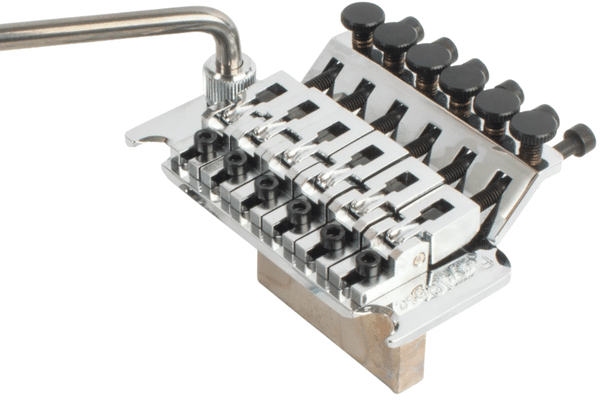
If you are an aggressive Metal or Rock guitar player who plays long sets, the bridge and strings can really rip up your right hand!
Pros And Cons Of Taping The Right Hand


Here are some things to consider when deciding to tape or not to tape. That is the question!
| Pros | Cons |
|---|---|
| Protects hand from sharp & pointy edges on bridge | Unsightly looking |
| Prevents guitar string cuts and abrasions on fingers | Can be cumbersome |
| Makes palm muting more comfortable | Can cause string buzzing |
Keep On Reading (Below) To Learn More About Each Topic
Can You Tape Both Hands?
No, I wouldn’t suggest you tape the left (fretting) hand. The left-hand needs to be free to move around the fretboard without accidentally sounding strings or causing string buzzing.
Players that have problems with the fretting hand typically have fingertip pain while they are developing calluses or other skin problems. I have seen players superglue open areas on their fingertips, which I wouldn’t recommend!
The best approach to improve fretting-hand discomfort is to use a guitar glove.
What Tape Is Best?
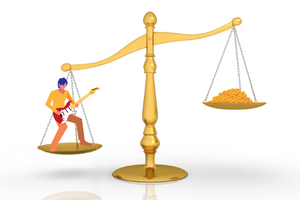
Every guitar player has their preferred type of tape that works best for them. Some tape types that have been commonly used are medical adhesive tape, cloth tape, and scotch tape. I have even seen duct tape used, which I definitely wouldn’t suggest!
If you sweat a lot, you’ll need to use tape with a strong enough adhesive, so that it sticks well
Cloth tape has the advantage of being softer and pliable.
Some players are allergic to the tape or its adhesive, so they use hypoallergenic tape.
Where To Tape Your Right Hand
Where you apply tape on your right hand depends on your problem and your playing style.
The most common places to apply tape are at the base of fingers, knuckles, palm, and the pinky side of the hand.
If you are scraping or cutting your skin on the guitar strings or upper part of the tremolo bridge, tape around the knuckles at the base of the fingers works well, as in the photo below.
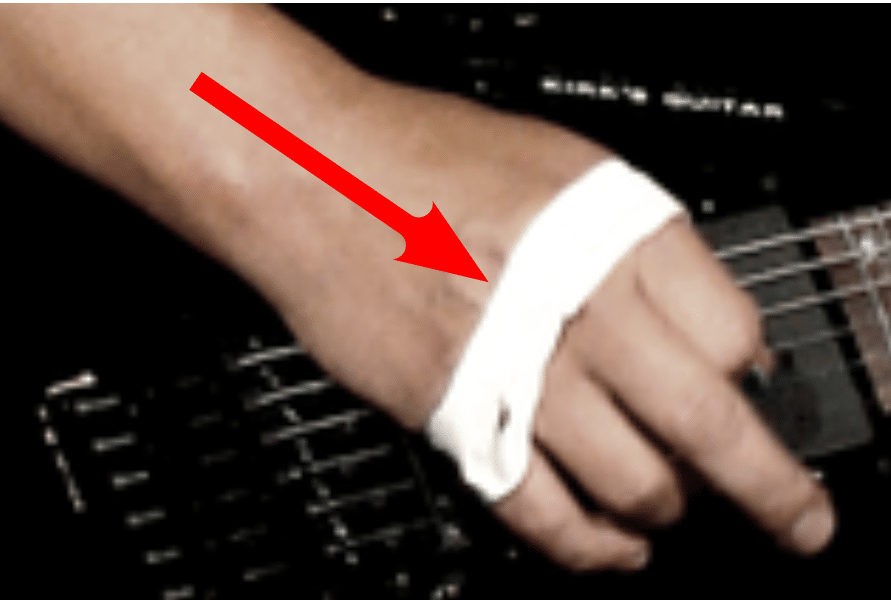
For players that palm mute over the tremolo bridge, taping that area of the palm is a good approach. If you mute with the side of your hand, try a piece of tape in that spot.
Common Taping Methods

Most guitar players use a roll of thin-width tape that can be wrapped over all the knuckles closest to the hand and around the palm side.
The tape needs to be tight enough that it does not come off when you’re playing but loose enough that you can close your hand by making a fist.
You can apply tape anywhere the strings or bridge are irritating or damaging the skin on your palm or fingers, but don’t go overboard. You want your hand to have a maximum range of mobility.
Feel free to use the type of tape that works best for you.
How About Taping The Fingernails?
I’ve seen Classical guitar players tape their fingernails and the skin on the tips of their fingers with scotch tape to avoid cracking and breaking.
This method works for any fingerpicking style when you are not using a pick (plectrum).
Some players cut the tape into a shape that fits directly over the front of each fingernail to keep it from chipping or cracking. I’ve also seen classical players glue on an artificial fingernail or use a brush-on nail hardener over the real one.
To protect the fingertip’s skin, wrap it around the fingernail and the back of the finger.

Wrap it tight enough that the tape won’t slip off, but loose enough so it doesn’t cause finger discomfort.
Can You Use A Guitar Glove Instead?
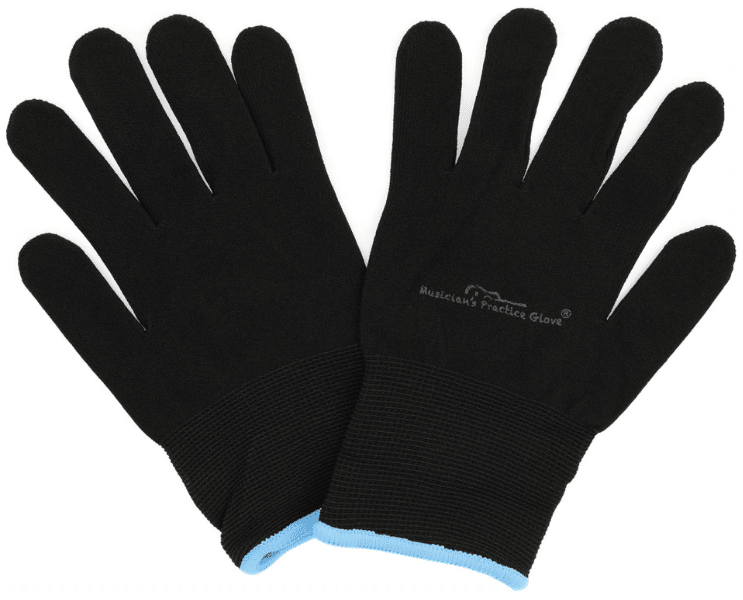
I have tried a guitar glove on my right hand to avoid the sharp or abrasive edges on tremolo bridges, which can work well.
The problem is that it doesn’t take long for a thin nylon glove to become frayed, which creates areas that can rip or get stuck on the bridge of an electric guitar while playing.
Bass guitar players typically find a glove on the right hand more effective than six or seven-string guitar players.
Guitar gloves last longer and generally work better when worn on the fretting hand.
Does Taping Your Right Hand Improve Tone?
No, taping your right hand generally won’t give you a better or clearer tone. It is a way to pad the sensitive or damaged areas of the hand and prevent the skin from directly contacting sharp areas on the guitar bridge.
Will Tape Improve Picking Speed?
Some players claim that taping the right hand and fingers improves their picking speed by allowing them to strum chords and pick individual strings with less or no discomfort. Fingerpickers have said it reduces the friction between the bare fingers and the strings.
Other players don’t find an increased speed benefit and do it purely for comfort.
Hardware Adjustments And Modifications
One way to avoid the need for taping your right hand may be to make adjustments or modifications to your guitar’s bridge and saddles.
Some players sand or file the rough edges and sharp pointy corners that can be present, especially on double-locking tremolo bridges. Other players smooth them over by applying tape to those areas of the bridge.
Sometimes, all that is needed is an adjustment or using replacement bridge parts.
Here’s an example of a Tele I bought that hurt my right hand after playing it for a while. Do you see the problem? The Allen screws were too long, so they stuck up above the bridge saddles. In addition, the tops of the screws were very rough.

I put in the proper size screws that did not protrude, and my problem disappeared! I wish the solution were always this simple.
Are You Qualified To Make Guitar Adjustments Or Modifications?
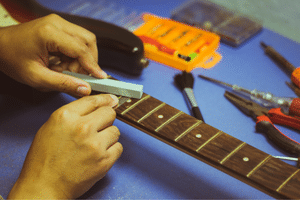
It’s great to work on your guitars, especially if you have a lot of them, but you should always be aware of your limitations.
Adjusting things like an electric guitar’s string height (action) or pickup height can be straightforward. Still, some adjustments require the proper training and experience, like adjusting a guitar’s truss rod.
You need to be careful when modifying a guitar bridge, or you could permanently damage it!
When you doubt your ability to adjust, repair, or modify your guitar, it’s always best to bring it to a competent guitar technician or luthier (guitar designer & builder). You can permanently damage your guitar, and it might never play and sound right again!
Making modifications to your guitar can void its manufacturer’s warranty and cause permanent damage to the instrument. Certain modifications are irreversible, so you may be stuck with them, even if you desperately want to restore the guitar to its original condition!
I learned that the hard way over the years until I did a three-year apprenticeship in a guitar repair shop. Now I have my own home workshop with the proper training and equipment to safely maintain and repair all my instruments.
Remember: “When In Doubt, Send It Out!”
Who Tapes Their Right Hand?
I’ve seen several Metal players and one classical guitar player tape their right hand and fingers. Although it’s ok to tape your hand for any musical style, electric guitar players with tremolo bridges who are aggressive pickers are likely to benefit most.
One famous guitar player is Metallica’s Kirk Hammett, who tapes the knuckle area at the base of the fingers on both sides of his hand, which protects the skin from damage by the strings and bridge.



Check out this short video from Armin, where Kirk Hammett explains why he tapes his right hand!
Related Article ➡ Do Guitar Gloves Work? – Are They Better Than Bare Fingers?
Frequently Asked Questions

Here are some of the questions I get asked about hand and finger problems.
If your question does not appear here, please put it in the comments, and I will get right back to you with an answer.
Can You Play Guitar While Wearing Gloves?
Yes, some players wear a guitar glove on both hands, but it may not be effective for some right-hand problems. The benefit of using tape is that it is a use-it-once and-throw-it-away solution, unlike a glove, which is worn repeatedly and can fray.
How Do You Toughen Your Fingers For Guitar Playing?
The best way to toughen the fingers on both hands is to play short sessions until the skin begins to thicken and protective calluses appear. Using a bigger gauge string set can help speed up the process. Never play through pain.
Why Do Guitarists Wear Wristbands?
Guitar players wear wristbands to help absorb sweat, support their wrists to help prevent injury from repetitive motion, and provide a smoother surface between the wrist and the guitar body.
Is Tape Harmful To Skin?
Tape or the tape’s adhesive can cause skin irritation, especially with repetitive use. Some players can have an allergic reaction that can affect the underlying skin. To alleviate the problem, use a pliable tape that is hypoallergenic.
Why Does Tape Not Stick To Skin?
Some tape may not be sticky enough to stick to a player’s skin, especially if the skin is dirty, oily or if the person sweats a lot. You may have to experiment to see which tape works best.
How Do You Prevent Hand Injuries When Playing Guitar?
The best way to prevent injuries is to practice slowly, especially when doing warm-up exercises. Stop playing immediately if you experience any hand, finger, or wrist pain. You may need to use skin protection, such as taping the hands and fingers or using guitar gloves.
Final Thoughts

I hope this article on why guitarists tape their hands was helpful. Aggressive electric players like Kirk Hammett and other Metal guitarists are more likely to tape their right hand to protect it from skin trauma from the stings and tremolo bridge. Taping can also make palm muting more comfortable.
Classical and other fingerstyle guitarists may tape their fingernails to protect them from chipping or cracking and tape their fingertips to pad their skin.
Taping the right hand can be unsightly and make playing cumbersome or strings more likely to buzz. Some players use clear tape because it is less likely to be seen onstage.
Taping the left (fretting) hand is not recommended since it would restrict hand and finger movement, hindering the quality of the sound and the ability to play quickly. Some players have found a nylon guitar glove helpful for left hand and finger problems.
There is no one type of tape that works best. Each player needs to find the tape that meets their comfort and playing requirements. It is possible to be allergic to tape or its adhesive.
Where to tape your right hand is a personal choice. You can experiment to see what works best for your guitar and playing style.
Taping your right hand will not improve your tone, but some players claim it improves their picking speed.
Modifying your guitar’s hardware can be an alternative to taping your hand, especially if you have a Floyd-Rose-type bridge with sharp or pointy edges. It’s best to bring your guitar to a certified technician or luthier to make the modifications to avoid permanent damage to the instrument.
Tell Me What You Think

Please leave a comment below if you enjoyed this article, have any questions about taping your hand, or want to give your point of view. I will be happy to help you.
- Do you tape your right hand? How does it help your playing?
- Besides Kirk Hammett, what famous players have you seen taping their right hand?
- Did this article help you decide if taping your right hand is right for you?
- What else is on your mind?

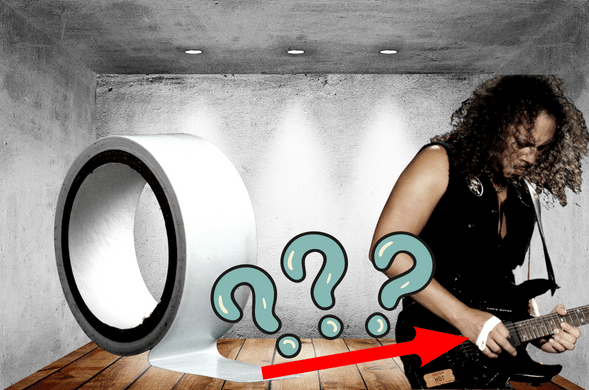

I’m not surprised to know that guitarists may tape their hands. To avoid cuts and bruises, I think that is the best approach to avoid those annoying things.
I haven’t experienced it myself; however, my father is an avid guitar player. Sometimes, he’ll put tape on his right hand to avoid those cuts and bruises.
Prior to putting on tape, my dad would get all kinds of cuts on his hand. So it’s good he started to take that approach.
Overall, a very good post to review. Thank you for sharing.
Hi, Eric
Thank You for your comments!
Yes, taping the right hand can be helpful, especially if you aggressively pick the strings!
I’m glad that it helped your father to be able to play more comfortably and effectively.
Happy Holidays! 😎
Frank 🎸
It’s no surprise to me that guitarists may tape their hands for protection. I used to play the harp, and I sometimes got blisters even on that fragile thing. So no wonder you would like to do everything to avoid bruises and blisters when you’re a professional guitar player. It was a great article to read and very helpful. It definitely takes some time to get your hands used to playing.
Hi, There
Thank You for your comments!
That’s awesome; the harp can be a difficult instrument to play!
Most players do whatever they can to keep on going, and taping the hand or using guitar gloves are more popular than people generally think.
Keep On Rockin’! 🤘
Frank 🎸